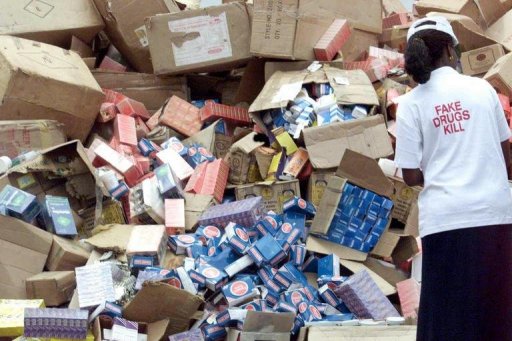From Cameroon to Ivory Coast, Kenya to the DR Congo, traders in counterfeit drugs do a thriving business with the utmost cynicism and sometimes at the cost of human lives.
The market is saturated with counterfeit anti-malaria drugs, painkillers, antibiotics and even rehydration serum. No domain of the pharmaceutical industry is spared by illicit manufacturers and traffickers, according to reports gathered by AFP offices across Africa.
About 100 traders like Djomo are set up under parasols in full view of everyone, their boxes heaped with medicines. Bubble-pack strips of pills are lined up in the wooden stalls.
People can even buy single pills at this market or even at some grocery stores. Vendors often mix fake medication with the real thing, which has either been legally acquired or stolen from supplies meant for hospitals and clinics.
At best, fake prescription drugs have no effect, acting like placebos, but at their worst, they are highly toxic. Either way they bring in vast sums of money for those behind the illicit traffic.
The UN Office on Drugs and Crime (UNODC) warned at a conference last February that counterfeit drugs are a multi-billion dollar business accounting for 30 percent of the pharmaceutical market in parts of Africa.
Kouassi, who made a priority of fighting the dangerous trade in fake medicines, escaped two murder bids at the headquarters of the Order of Pharmacists. “That’s a sign that major interests are in play and that it’s not just a matter of small-scale local traffickers,” he said.
The phenomenon is spreading and represents between 20 and 25 percent of the drug market in Ivory Coast, adds Kouassi. In Kenya, 30 percent of drugs sold in 2012 were either fake or counterfeit, according to the Pharmacy and Poisons Board of Kenya. Cameroon health officials give a similar figure.
However, in the Democratic Republic of Congo, as in many other African countries, there are no national statistics, just records of frequent drugs seizures.
In Nigeria — once known as a major source of counterfeit medicines — phony drugs and real ones that had passed their expiry date made up 70 percent of sales in 2002, according to the World Health Organisation.
Since then, in the continent’s biggest market with some 160 million people, officials say that high-profile efforts have greatly reduced the number of fake or adulterated drugs, but reliable figures are hard to obtain.
Health authorities have set up a service to enable consumers to check the authenticity of drugs by verifying the PIN serial number on the product label via an SMS message.
The outstanding exception on the continent in fighting the illicit drug trade is South Africa, which has a strictly enforced licencing system, according to Griffith Molewa, head of law enforcement at the Medicines Control Council.
In most other countries, measures against the counterfeit drug trade are limited to police raids on public markets to seize fake or adulterated products, along with public information and awareness campaigns, which appear to have little effect on consumers.
For in countries where medical expenses — from drugs to hospitalisation — are not even partly reimbursed by the state, the relatively cheap price of street medication trumps the risk factor for many.

COMMENTS
Please let us know if you're having issues with commenting.